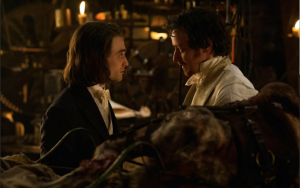VICTOR FRANKENSTEIN: 3 STARS. “stitches a monstrous story together.”
 Just as Dr. Frankenstein stitched his creation together from the bodies of several people “Victor Frankenstein,” a new film starring James McAvoy and Daniel Radcliffe, stitches a story together using bits and pieces of other monster movies.
Just as Dr. Frankenstein stitched his creation together from the bodies of several people “Victor Frankenstein,” a new film starring James McAvoy and Daniel Radcliffe, stitches a story together using bits and pieces of other monster movies.
In a flip flop from most Frankenstein movies, the story begins with the nameless, hunchbacked circus freak that would become Igor (Daniel Radcliffe), studying the “science of life” when he isn’t pining after beautiful trapeze artist Lorelei (Jessica Brown Findlay). His detailed anatomical drawings earn the ridicule of his fellow carnies but when Lorelei is injured after a fall his quick thinking saves her life.
Victor Frankenstein, seeing his potential, smuggles the hunchback out of the circus with an eye toward making him his protégé. The good (or is he?) doctor gives his new friend the name of an old, deceased pal. Turns out the newly minted Igor’s back bump is just an abscess which, once drained, will allow him to stand upright and fit in with upper class Victorian society.
Frankenstein wants to use Igor’s knowledge of anatomy to help construct the “larger whole” the doctor has in mind. It will be, he says, “a scientific enterprise that will change the world.” In other words, he’s looking to reanimate the dead. “I’m of the opinion that death is a temporary condition,” he says.
As the pair work toward their scientific breakthrough Lorelei re-enters the story and a religious policeman (Andrew Scott) sniffs out sin, making it is his moral duty to stop Frankenstein’s experiments. “He reeks of an evil, sinful mischief.”
In the end Igor must look into his soul to decide whether his mentor’s motives are scientific or psychological.
As the title would suggest “Victor Frankenstein” is about the man not the monster. Just as Frankenstein’s work “challenges natural order,” the movie challenges our knowledge of the story, mixing-and-matching details from Mary Shelley’s source novel (which did not feature Igor) with the accumulated mythology from the dozens of films that followed.
Igor takes on a much larger role in the story, transcending the traditional, “Yes master,” assistant to become the movie’s moral compass and emotional core. The movie isn’t really about the monster or creating life. Victor Frankenstein figures out how to create life in a laboratory but, more importantly, he gives Igor a life—changing him from abused circus freak to English gentleman.
Victor is still not one to allow morality stand in the way of science, but here the psychological drama trumps any talk of ethics. Questions as to the implications of bringing the dead back to life are raised and dismissed with clever hypotheticals like, “Imagine that a murdered man can stand in court to face his murderer,” or simply lost in the frenetic action that keeps the movie moving at warp speed.
Also gone are any Gothic overtones. The setting and dusty old laboratories will look familiar to fans of the genre but get lost in the film’s rapid pacing. Director Paul McGuigan seems more intent on keeping the movie moving than fleshing out the story or allowing the atmosphere to take hold. Screenwriter Max Landis can be credited with devising a new take on an old story and doing so with some humour—“We’ll give him a flat head!” says Victor. Why? “Because I like flat heads!”—but both the direction and script feel too modern to snugly fit into the Frankenstein canon.
